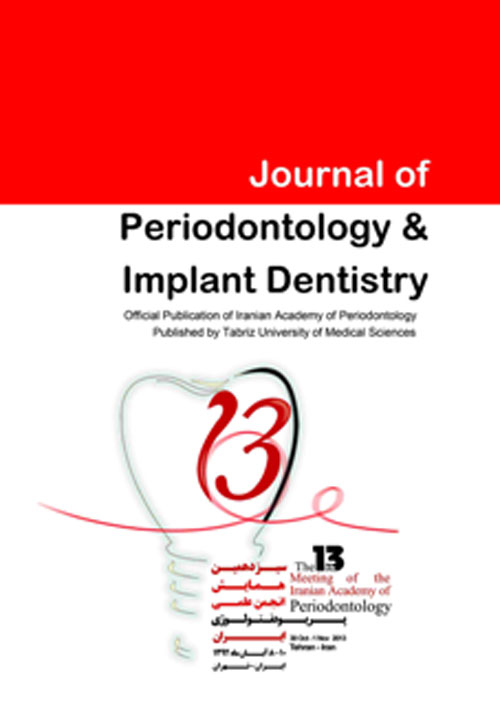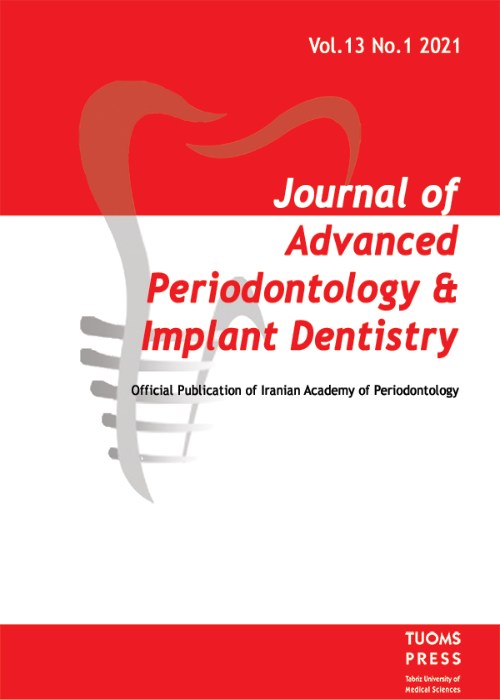فهرست مطالب

Journal of Advanced Periodontology and Implant Dentistry
Volume:7 Issue: 1, Jun 2015
- تاریخ انتشار: 1394/03/16
- تعداد عناوین: 6
-
-
Pages 1-6Background And AimsGingival hyperplasia, a relatively common side effect of antiepileptic and anticonvulsant drugs, occurs in 30‒50% of patients taking phenytoin and 25‒81% of those taking cyclosporine. Gingival hyperplasia due to lack of balance between extracellular synthesis and degradation is associated with increased production of IL-1B, IL-6 and IL-8 by gingival fibroblasts. Tissue level of IL-17 increases in inflammatory conditions. Since the role of IL-17 and patient age in gingival hyperplasia is still unclear, this study aimed to compare the level of IL-17 produced by gingival fibroblasts in children and adults.Materials And MethodsThis study was conducted on biopsy specimens obtained from the healthy gingiva of 4 adults, 35‒42 years of age, undergoing crown lengthening surgery and 4 children, aged 4‒11 years, undergoing impacted tooth surgery. Biopsy specimens were cultured in a mixture of Dulbecco’s Modified Eagle’s Medium (DMEM), penicillin, 1% streptomycin and 10% fetal bovine serum (FBS) at 37°C and 5% CO2. The specimens were monitored for contamination and cell proliferation and the medium was refreshed if necessary.ResultsThe baseline levels of IL-17 produced by gingival fibroblasts isolated from children and adults were not significantly different from those after the addition of cyclosporine or phenytoin. The two groups of children and adults were not significantly different in terms of the production of IL-17 by gingival fibroblasts. The two groups of children and adults were not significantly different in terms of the production of IL-17 at baseline or after exposure to cyclosporine or phenytoin.ConclusionIL-17 inflammatory cytokine does not play a role in gingival hyperplasia in children and adults.
-
Pages 7-14Background And AimsThe aim of this study was to evaluate the possible effects of obesity on the local (salivary) and systemic TNF-α and IL-6 levels in patients with chronic periodontitis (CP).Materials And MethodsThis study included 88 subjects assigned to four groups of 22 subjects each, as follows: group O+P+ (patients with obesity and CP), group O-P+ (patients with normal weight and CP), group O+P- (periodontally healthy patients with obesity), and the control group, group O-P- (periodontally healthy patients with normal weight). Serum and salivary samples were obtained a week before the recording of clinical periodontal parameters. Local and systemic TNF-α and IL-6 levels were determined biochemically.ResultsIn serum and saliva, both TNF-α and IL-6 levels were the lowest in O-P- group (P < 0.05). The highest TNF-α and IL-6 levels were observed in O+P+ group, while only IL-6 levels were statistically significant (P < 0.05).ConclusionObesity upregulated the salivary and serum levels of TNF-α and IL-6. In patients with periodontitis, who were also obese, the serum and saliva levels of IL-6 were significantly high. Obesity might play a destructive and provocative role in the pathogenesis of periodontitis by negatively affecting IL-6 levels.
-
Pages 15-20Background And AimsPrevious researches, conducted mostly on extracted teeth, have shown that efficacy of calculus removal decreases with increasing pocket depth, but there is still a lack of clinical studies concerning the correlation be-tween residual calculus and varying pocket depths. The objective of the present clinical study was to assess the efficiency of mechanical tooth depuration by closed approach in terms of pocket depth, tooth type and tooth surface.Materials And MethodsFifty subjects with chronic periodontitis underwent scaling and root planing by closed ap-proach. After instrumentation, 225 teeth (92 single-rooted and 133 multi-rooted) with pocket depths of 4 mm and 5‒8 mm were evaluated for calculus-positive surfaces by surgical flap elevation. Residual calculus was assigned a score from 1 to 3 based on the distance in mm from CEJ or furcation.Results11.4% of surfaces were calculus-positive. On inter-pocket depth comparison, calculus-positive surfaces were present in both single- and multi-rooted teeth, with no significant differences. Residual calculus score 1 was significantly associated with a pocket depth of 4 mm and scores 2 and 3 with pocket depths 5‒8 mm in overall distribution and for multi-rooted teeth.ConclusionDuring mechanical tooth depuration by closed approach, no significant correlation was found between percentages of calculus-positive surfaces and increasing pocket depth.
-
Pages 21-25Background And AimsThe goal of this study was to evaluate the clinical efficacy of a standard oral hygiene routine (daily tooth brushing and flossing) along with cetylpyridinium chloride (CPC) mouthwash in comparison to the same pro-tocol without mouthwash in chronic periodontitis patients during a 14-day period.Materials And MethodsThis comparative study was carried out or 50 non-smoking patients with chronic periodontitis; 25 patients followed an oral hygiene regimen using a toothbrush and dental floss (control group) and the remaining 25 used the mentioned protocol along with CPC mouthwash (test group) for 14 days. The plaque index (PI), modified gingival index (MGI) and probing pocket depth (PPD) were assessed. Wilcoxon and Mann-Whitney U tests were used to evaluate and compare the prevalence of indices between the two groups. Statistical significance was set at P<0.05.ResultsThe results showed greater improvement of MGI in the test group (P=0.001). No statistically significant differences were observed in PI (P=0.47) and PPD (P=0.43) between the two groups.ConclusionAdding mouthwash to a standard oral hygiene regimen may improve some clinical gingival parameters when compared with an oral hygiene routine without a mouthwash.Keywords: Dental plaque, hygiene, mouthwash, periodontitis
-
Pages 26-32Background And AimsThe aim of this investigation was to compare clinical and microbiological effectiveness of ad-junctive photodynamic therapy (PDT) in the treatment of periodontitis.Materials And MethodsTwenty-four subjects (14 women and 10 men) diagnosed with moderate to severe chronic periodontitis underwent scaling and root planing (SRP). One tooth in each quadrant (probing depth >4 mm) was selected for combined PDT and SRP (PDT group) with the contralateral tooth (SRP group), as a control site (SRP-treated site). Clinical assessment was carried out at baseline and 1 and 3 month later. Microbial assessment was carried out by real-time PCR. Periodontal probing depth (PPD) was considered as the primary outcome.ResultsBaseline PPDs were 4.86±0.77 and 4.04±0.65 in the SRP and PDT groups, respectively (P>0.05), which decreased to 3.65±0.58 in the SRP and 3.86±0.56 in the PDT groups after one month and to 3.20±0.68 in the SRP and 3.34±0.56 in the PDT groups three months later. Although values decreased significantly in both groups after one (P=0.001 in the SRP and P=0.001 in the PDT groups) and three months (P=0.001 in the SRP and P=0.001 in the PDT groups) the inter-group differences were not significant after one (P=0.25) and three months (P=0.51). Clinical measurements showed significant decreases after one and three months at both sites, without inter-group differences, except for bleeding on probing after one (P=0.004) and three months (P=0.0001).ConclusionSubgingival application of PDT combined with scaling and root planing could not improve clinical and mi-crobiological results.
-
Page 33The loss of the papilla can lead to cosmetic deformities, phonetic problems and lateral food impaction. Several reasons con-tribute to the loss of interdental papillae and the establishment of “black triangles” between teeth. In 1996, Han and Takei proposed a novel approach based on the use of a semi-lunar incision placed in the alveolar mucosa of the interdental area. The present case report, utilizing their approach, showed that within limits papillary reconstruction is achievable.


